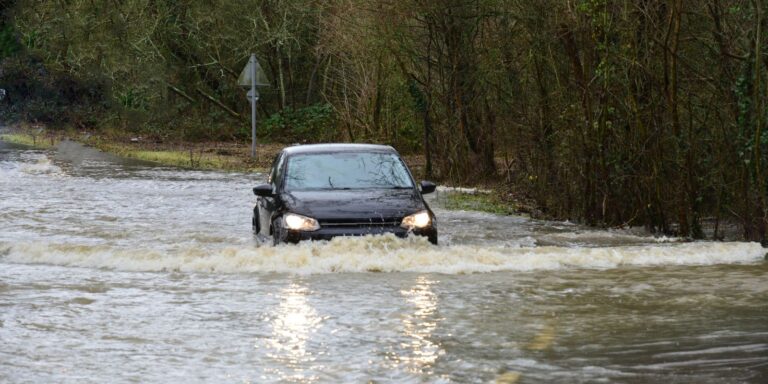When heavy rainfall strikes, it can transform familiar roads into treacherous hazards. Today, parts of South Wales are under water, with Storm Bert bringing chaos over the weekend. From Pontypridd’s high street, which sits perilously close to the River Taff, to suburban areas of Cardiff where roads and fields are submerged, the impact is clear. Flood warnings from Natural Resources Wales highlight the seriousness of the situation, but still, some drivers take unnecessary risks.
Driving through flooded water might seem like a shortcut or a minor inconvenience, but it’s far more dangerous than many realise. Here are some key reasons why you should never attempt it, no matter how shallow it appears.
1. You Don’t Know How Deep It Is
Flooded water can be incredibly deceptive. What looks like a small puddle might hide a deep sinkhole, uneven ground, or debris. Just 30cm of flowing water is enough to sweep a car away, while as little as 15cm can cause a loss of control. Even if the road is familiar, floodwater changes everything. Depth markers may be absent, and drainage systems can make some areas unexpectedly hazardous.
2. Floodwater is Unpredictable
Water flows and currents are unpredictable and can shift rapidly. A steady-looking patch might hide strong undercurrents that destabilise your vehicle. Roads can also collapse under the weight of water, creating sinkholes or washed-out sections that can trap or damage vehicles.
3. Your Vehicle is Vulnerable
Modern cars, with all their technology, are not designed for submersion. Water entering the engine through the air intake can cause irreversible damage, known as hydrostatic lock. Electrical systems can short-circuit, and brakes may fail. Even if you make it through, you might face thousands of pounds in repair costs or a written-off vehicle.
4. It Puts Lives at Risk
By driving into floodwater, you risk more than just your vehicle. Rescuing stranded vehicles diverts emergency services from other critical tasks. Worse, if your car is swept away, you endanger not only yourself but also anyone else in the water, including first responders trying to save you.
5. Floodwater is Contaminated
Floodwater isn’t clean. It often contains sewage, chemicals, and debris, posing health risks if it enters your car or comes into contact with you. Even driving through and splashing it up can spread contamination to other vehicles or nearby properties.
What Should You Do Instead?
If you encounter a flooded road:
- Turn Around: The simplest and safest option is to find an alternative route. Even if it takes longer, it’s worth it.
- Stay Informed: Use resources like Natural Resources Wales for updates and avoid areas with flood warnings.
- Think Ahead: Plan your journeys during heavy rainfall and avoid travelling unnecessarily in flood-prone areas.
Flooded roads are dangerous and unpredictable. No shortcut or saved time is worth the potential risks to your life, your vehicle, or others. As South Wales faces the aftermath of Storm Bert, let’s prioritise safety and avoid driving through flooded water at all costs. Remember: “Turn around, don’t drown.”

